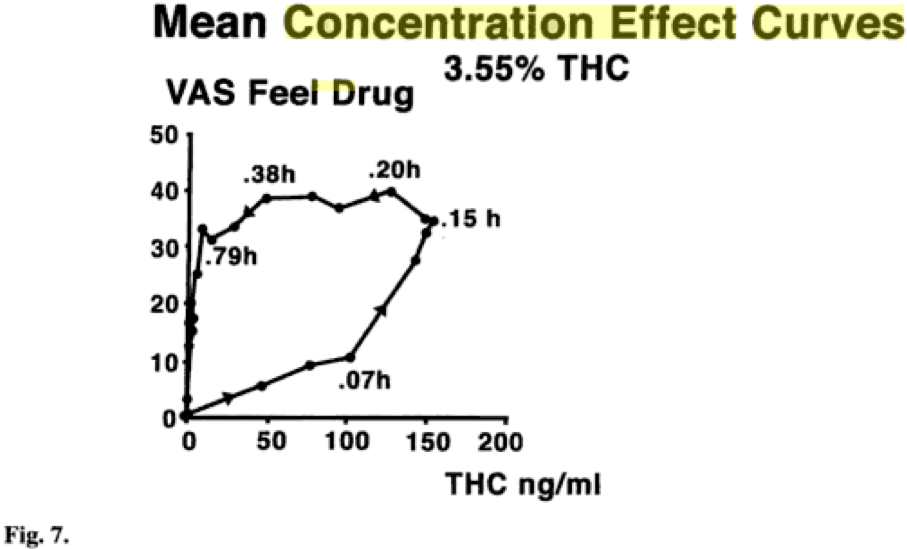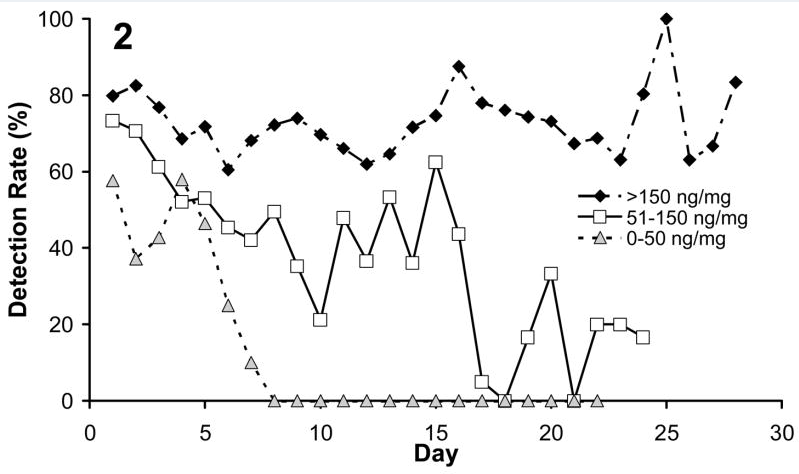I cannot imagine that a single rational and sane person cares for drug impaired drivers to be on the road among us driving what amounts to a guided missile weighing about 3,000 to 5,500 pounds or more. As has been shown time and again, a drug intoxicated driver can be a weapon of mass destruction. The rightful prosecution and appropriate punishment of drug impaired drivers is a good thing.
What I suggest is not “good,” “just,” or even “fair” is the prosecution and draconian punishment of non-impaired drivers as if they were dangerous drugged drivers.
What rational person can disagree?
Is this what is happening in the United States today? Yes
This question is one of the most beautifully articulate and horribly complicated issues possible when it comes to marijuana in particular.
We have blogged here before about the general notion of the perils of interpreting an analytical chemistry result stand alone: “Pharmacology For Lawyers Part 6: Elucidating Pharmacodynamic Effect from an Analytical Chemistry Result“
What makes marijuana also particularly interesting is the well-known and well-studied (primarily by Marilyn A. Huestis, Ph.D., Senior Investigator Chief, Chemistry and Drug Metabolism Section in the National Institutes on Drug Abuse) counter clockwise hysteresis effect in terms of the user’s own subjective reported pharmacodynamic properties and drug concentration. This is shown on the graph below.

- The counterclockwise hysteresis of marijuana subjective reporting over the course of time versus blood concentration of tetrahydrocannabinol (THC)
As one can clearly see from the graph above, and what is important about these hysteresis curves is that if you look at a particular concentration in plasma, such as 100 ng/mL of the parent drug Tetrahydrocannabinol (THC), you have very little effect at one point in time, but at the same drug concentration (100 ng/mL) at a later time one perceives very strong effects.
For this reason alone, it should be very very difficult for the prosecution to convict a marijuana user for an impairment based DUID. In fact this whole phenomenon is why per se drug offenses in terms of DUID are truly unscientific.
But there is more.
The state legislatures around the United States have authorized the full prosecution and draconian punishment of non-impaired drivers as if they were dangerous drugged drivers. The prosecution of marijuana users at per se levels for marijuana at or around the time of driving can and is based upon presence (sometimes in trace amounts even) of pharmacodynamically inactive metabolite 11-nor-9-Carboxy-THC, also known as 11-nor-9-carboxy-delta-9-tetrahydrocannabinol, 11-COOH-THC, THC-COOH, and THC-11-oic acid. Presence of only the pharmacologically inactive metabolite is evidence of NON-IMPAIRMENT at the time of the collection of the specimen. If anyone only has this inactive metabolite alone in their specimen no matter what the level, they are not impaired. It is just that simple. This is even more pronounced if the specimen is urine which is simply an unpinned history of use at some past time and not ever reflective of impairment at the time of collection.
But there is more.
In addition to the unscientific liability that our legislatures have decided to attach to evidence of non-impaired driving that we just discussed, the evidence of past use of marijuana and the presence of the inactive metabolite THC-COOH could be far, far removed from last use.
From the abstract of “Urinary Elimination of 11-Nor-9-carboxy-9-tetrahydrocannnabinol in Cannabis Users During Continuously Monitored Abstinence” by Robert S. Goodwin, William D. Darwin, C. Nora Chiang, Ming Shih, Shou-Hua Li, and Marilyn A. Huestis:
The time course of 11-nor-9-carboxy-Δ9-tetrahydrocannnabinol (THCCOOH) elimination in urine was characterized in 60 cannabis users during 24 h monitored abstinence on a closed research unit for up to 30 days. 6158 individual urine specimens were screened by immunoassay with values ≥50 ng/mL classified as positive. Urine specimens were confirmed for THCCOOH by gas chromatography/mass spectrometry following base hydrolysis and liquid-liquid or solid phase extraction. In 60%, the maximum creatinine normalized concentration occurred in the first urine specimen; in 40%, peaks occurred as long as 2.9 days after admission. Data were divided into three groups, 0 – 50, 51 – 150, and >150 ng/mg, based on the creatinine corrected initial THCCOOH concentration. There were statistically significant correlations between groups and number of days until first negative and last positive urine specimens; mean number of days were 0.6 and 4.3, 3.2 and 9.7, and 4.7 and 15.4 days respectively, for the three groups. These data provide guidelines for interpreting urine cannabinoid test results and suggest appropriate detection windows for differentiating new cannabis use from residual drug excretion.

- Mean detection rate each day after the first negative (<50 ng/mL) cannabinoid urine specimen. Cannabis users were separated into three groups (0–50, 51–150 and >150 ng/mg) according to creatinine-normalized THCCOOH concentrations in the first specimen collected at admission. Mean detection rate (number of positive specimens in a day/total number of specimens collected that day multiplied by 100) for the three groups was determined each day after the first negative specimen.
The underlying data that supports the above figure is presented here. The data clearly shows that as long as 28 days days can elapse between the first recorded “negative” (really under the limit of detection) test and last positive specimen even after total abstinence. In short due to lipid release a positive can occur in chronic users that is artefactual and not probative (and truly prejudicial) to the crime sought to be punished which is drug-impaired driving.
And later, the authors of this study conclude:
This study monitored cannabis users on a closed research unit under continuous medical surveillance during cannabis abstinence for up to 30 days. The greater the creatinine corrected initial THCCOOH concentration, the greater the interval until the first negative and last positive specimens, the greater the window of drug detection and the higher the detection rate of positive specimens. Cannabis users who present with an initial normalized THCCOOH concentration >150 ng/mg can be expected to have detection rates between 60 and 100% for 28 days after the first negative urine test. These data increase our understanding of THCCOOH urinary elimination and provide guidelines for the interpretation of urine cannabinoid test results. They also suggest appropriate detection windows for differentiating new cannabis use from residual drug excretion based on creatinine normalized THCCOOH urine data.
This phenomenon proves to be quite problematic in probation or parole violation hearings for alleged marijuana use. When one is sentenced to a term of probation and/or parole typically there is a condition that there is to be no use of illicit drugs (marijuana included). Typically the specimen collected is urine. Typically the probation or parole officer uses the 9 Panel ONESCREEN Multi-Drug Test Cup or something similar. Atypically the results are sent off for confirmation by GC-MS. The screening tests are presented as truth and not as they should be which is as a screening device with easy, cheap and rapid results with high rates of false positive based upon cross-reactivity and lack of true specificity. This same data above is typically unknown to the courts or to the probation/parole officers who when confronted with a negative urine screen then days later are presented with a positive urine screen cry foul and accuse the probationer/parolee of use. This may be true in some cases for certain, but the combination of the lipid release phenomenon described above, the poor testing method, the undertrained and uneducated probation and parole officer playing chemist, and the lack of knowledge of all of these limitations may also result in wrongly accusations and false findings of violations. The issue is that we don’t know.
But there is more.
Plus, we cannot take for granted that the analytical chemistry result is true and correct. The detection of THC and its metabolites by screening tests from a biological sample can provide for false positives for any number of reasons. Plus, the confirmation (if completed at all) by GC-MS is a very tricky process involving extraction and derivatization typically in terms of the preparative chromatography steps to even make the possibility of GC-MS detection possible. As recently discovered and published in the Journal of Analytical Toxicology (January/February 2012, Voume 36, No. 1, pages 61-65) entitled “Production of Identical Retention Times and Mass Spectra for Δ9-Tetrahydrocannabinol and Cannabidiol Following Derivatization with Trifluoracetic Anhydride with 1,1,1,3,3,3-Hexafluoroisopropanol” by Rebecca Andrews and Sue Paterson informs us of the possibility of error in examining biological samples (plasma or whole blood) in this crucial preparative chromatography step. The THC assays that use the TFAA (trifluoroacetic anhydride) derivatization methods have been found to result in converting cannabidiol (CBD) to the same derivatives as THC. The CBD derivatives have the same GC retention times and mass spectra as the THC derivatives. The authors conclude that when targeting and attempting to quantify, this derivatization method must not be used as it can produce a false positive in terms of the qualitative measurement, and even if objectively present, will overstate the true blood concentration.
The interpretation (elucidation) of the SIM and mass spectra often reveals match factor scores and probability scores not at 100%. The selection of diagnostic ions and ratios that are thought to reflective of THC is not absolutely settled in the analytical chemistry/forensic chemistry world. The quantitation of THC and its metabolites can be performed in a metrologically unacceptable manner.
Yet despite knowing this, we consciously choose to prosecute and convict. Sad but true. The emperor has no clothes. False convictions based not on science and perhaps even not even rationally related to the harm sought to be avoided abound.



Will says:
Thank you for presenting the dire problems inherent in testing for THC-COOH as a marker of current or even recent use. Apparently, the problem is even greater for those formerly regular users with high body fat (using BMI as a rough proxy). The literature describes a case in which a woman with a high BMI continued to display measurable levels of THC-COOH 77 days after last use. And temporary spikes in THC-COOH in the blood and urine can be precipitated by any activity that causes lipolysis, such as exercise and dieting.
Nickle says:
Cannabis drug testing is a sad joke at best. I do not consume red meat and therefore, have lower creatine levels and do not take a supplement. After taking a drug test for an employment opportunity, I was told that my test had to be sent off to another lab because it was “diluted” because my creatine levels were low. My results came back WELL UNDER the 50 ng/ml cutoff level for cannabis, but because my creatine levels weren’t “normal,” Labcorps gave my results a dilute positive….. UMMMM, how was what Labcorps did legal? I feel discriminated against for not eating red meat 🙁 I tested BELOW the cutoff point for a positive result, but because I choose to NOT eat red meat, I was given a dilute positive result.